Global Buckling Investigation of the Flanged Cruciform H-shapes Columns (FCHCs)
Abstract
1. Introduction
2. Calculation of Geometric Characteristics of the FCHC
3. Numerical Analysis Method and Verification
3.1. Finite Element Model
3.2. Verification of ABAQUS Analysis
4. Design of Analysis Specimens
5. Results, Observations, and Discussion
5.1. Load-Deformation Curves
5.2. Buckling Mode and Buckling Deformation
5.3. Global Flexural Buckling Factors in Current Design Codes
5.4. Proposed Column Curves
6. Conclusions
- The representative values of comprehensive imperfections given in GB50017-2017 are suitable for global buckling analysis on FCHCs. The analysis results are a little bit conservative;
- The overall instability form of FHCs with initial imperfections is flexural buckling around the axis of symmetry, and overall torsional buckling will not occur. Hot-rolled H-shapes selected according to Chinese standards generally do not undergo local buckling;
- When or , curve b in GB 50017-2017 and EN 1993-1-1 are suggested for the global buckling design of FCHCs. When the , take curve c in both GB 50017-2017 and EN 1993-1-1;
- New column curves proposed in the paper to predict the buckling strength of FCHCs are accurate, but they still need more investigation to confirm. The fitting imperfection factor is α = 0.410 based on the expression in EN 1993-1-1, and the corresponding factors based on the expression in GB50017-2017 are α1 = 0.60, α2 = 0.970, and α3 = 0.320.
7. Patents
Author Contributions
Funding
Acknowledgments
Conflicts of Interest
References
- Hensman, J.; Nethercot, D. Numerical study of unbraced composite frames: Generation of data to validate use of the wind moment method of design. J. Constr. Steel Res. 2001, 57, 791–809. [Google Scholar] [CrossRef]
- GB/T 11263-2017. Hot Rolled H and T Section Steel; General Administration of Quality Supervision; Standards Press of China: Beijing, China, 2017. (In Chinese) [Google Scholar]
- Li, Y.; Zhou, T.; Zhang, L.; Ding, J.; Zhang, X. Distortional buckling behavior of cold-formed steel built-up closed section columns. Thin-Walled Struct. 2021, 166, 108069. [Google Scholar] [CrossRef]
- Roy, K.; Chen, B.; Fang, Z.; Uzzaman, A.; Chen, X.; Lim, J.B. Local and distortional buckling behaviour of back-to-back built-up aluminium alloy channel section columns. Thin-Walled Struct. 2021, 163, 107713. [Google Scholar] [CrossRef]
- Uang, C.-M.; Bruneau, M. State-of-the-Art Review on Seismic Design of Steel Structures. J. Struct. Eng. 2018, 144, 03118002. [Google Scholar] [CrossRef]
- Tahir, M.M.; Shek, P.N.; Sulaiman, A.; Tan, C.S. Experimental investigation of short cruciform columns using universal beam sections. Constr. Build. Mater. 2009, 23, 1354–1364. [Google Scholar] [CrossRef]
- Ngian, S.P.; Tahir, M.M.; Sulaiman, A.; Siang, T.C. Wind-moment design of semi-rigid un-braced steel frames using cruciform column (CCUB) section. Int. J. Steel Struct. 2015, 15, 115–124. [Google Scholar] [CrossRef][Green Version]
- Hawileh, R.A.; Abed, F.; Abu-Obeidah, A.S.; Abdalla, J.A. Experimental investigation of inelastic buckling of built-up steel columns. Steel Compos. Struct. 2012, 13, 295–308. [Google Scholar] [CrossRef]
- Kiani, B.K.; Torabian, S.; Mirghaderi, S.R. Local seismic stability of flanged cruciform sections (FCSs). Eng. Struct. 2015, 96, 126–138. [Google Scholar] [CrossRef]
- Naderian, H.; Sanches, R.; Mercan, O.; Kushner, P.; Azhari, M.; Ronagh, H. Stability of stiffened cruciform steel columns under shear and compression by the complex finite strip method. Thin-Walled Struct. 2019, 136, 221–234. [Google Scholar] [CrossRef]
- Zhang, A.L.; Yu, J.; Xu, M.; Liu, X.W.; Liu, H.J. Experimental research on steel specially shaped columns with cruciform section under cyclic loading. J. Build. Struct. 2010, 31, 11–19. (In Chinese) [Google Scholar]
- ANSI/AISC 358s2-20. Prequalified Connections for Special and Intermediate Steel Moment Frames for Seismic Applications, Including Supplements No. 1 and No. 2; American Istitute of Steel Constuction: Chicago, IL, USA, 2020. [Google Scholar]
- Waheed, A.; Vafaei, M.; Alih, S.C.; Ullah, R. Experimental and numerical investigations on the seismic response of built-up battened columns. J. Constr. Steel Res. 2020, 174, 106296. [Google Scholar] [CrossRef]
- Fraternali, F.; Spadea, S.; Ascione, L. Buckling behavior of curved composite beams with different elastic response in tension and compression. Compos. Struct. 2013, 100, 280–289. [Google Scholar] [CrossRef]
- Mascolo, I.; Modano, M.; Fiorillo, A.; Fulgione, M.; Pasquino, V.; Fraternali, F. Experimental and Numerical Study on the Lateral-Torsional Buckling of Steel C-Beams with Variable Cross-Section. Metals 2018, 8, 941. [Google Scholar] [CrossRef]
- GB50017-2017. Standard for Design of Steel Structures; China Architecture & Building Press: Beijing, China, 2018. (In Chinese) [Google Scholar]
- EN1993-1-1:2005. Eurocode 3: Design of Steel Structures—Part 1-1: General Rules and Rules for Buildings; European Committee for Standardiza-tion: Brussels, Belgium, 2005. [Google Scholar]
- ANSI/AISC 360-16. Specification for Structural Steel Buildings; American Institute of Steel Construction: Chicago, IL, USA, 2016. [Google Scholar]
- Yang, C.; Song, Z.S.; Chen, X.W. Analysis on torsional in stability ultimate bearing capacity of flanged members with cruciform section subjected to axial load. Steel Constr. 2019, 34, 25-29+47. (In Chinese) [Google Scholar]
- Xu, Y.; Lu, L.; Zheng, H. Finite Element Analysis of Weak-Axis Composite Connections Under Cyclic Loading. Int. J. Steel Struct. 2018, 19, 82–95. [Google Scholar] [CrossRef]
- Ban, H.Y.; Shi, G.; Shi, Y.J.; Wang, Y.Q. Experimental and numerical investigation on the overall buckling behavior of Q460 high strength steel welded I-section columns. China Civ. Eng. J. 2013, 46, 1–9. (In Chinese) [Google Scholar]
- Deniziak, P.; Winkelmann, K. Influence of nonlinearities on the efficiency and accuracy of FEM calculations on the example of a steel build-up thin-walled column. MATEC Web Conf. 2018, 219, 02010. [Google Scholar] [CrossRef][Green Version]
- Trahair, N.S.; Bradford, M.A.; Nethercot, D.A.; Gardner, L. The Behaviour and Design of Steel Structures to EC3, 4th ed.; Spon Press: London, UK, 2008. [Google Scholar]

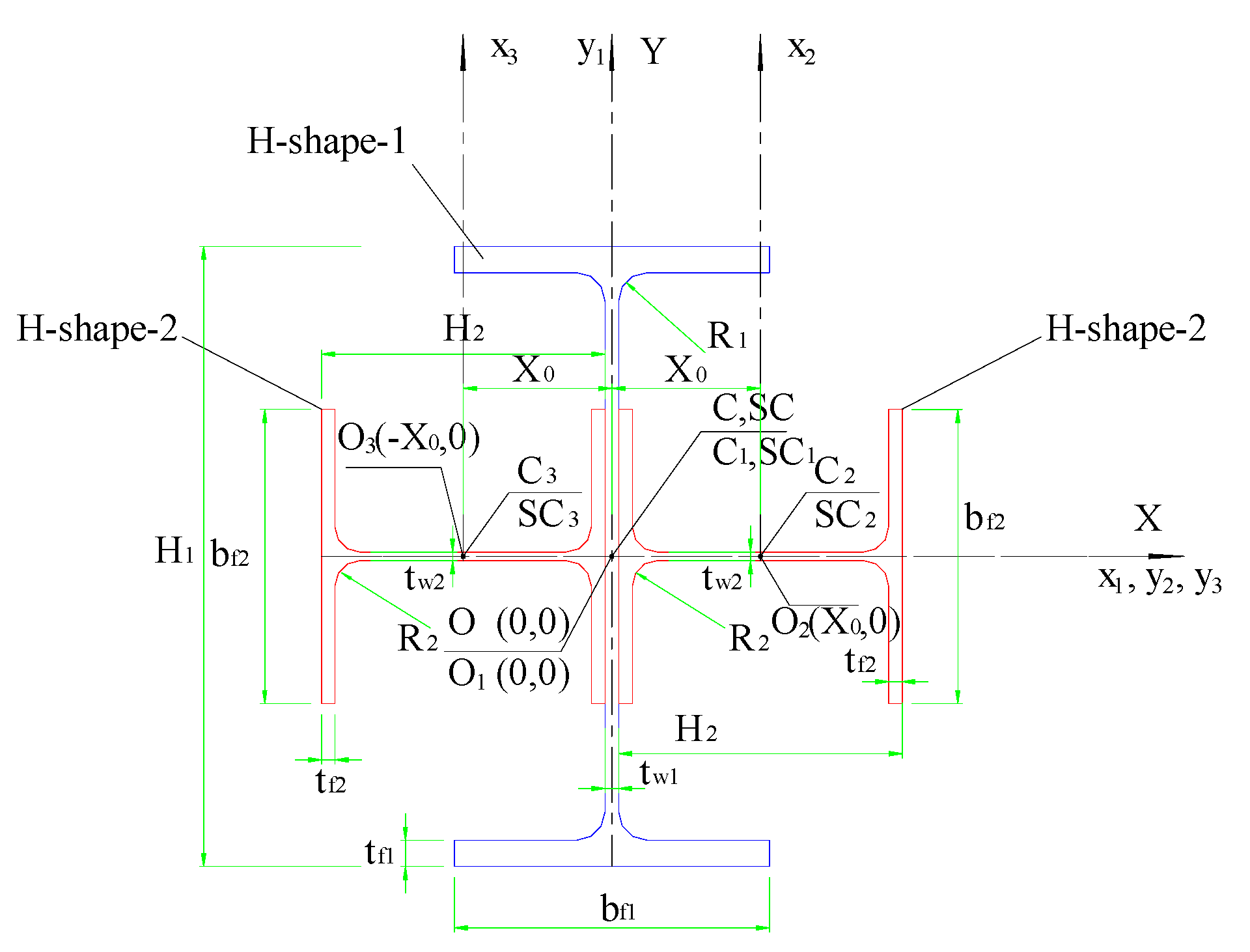
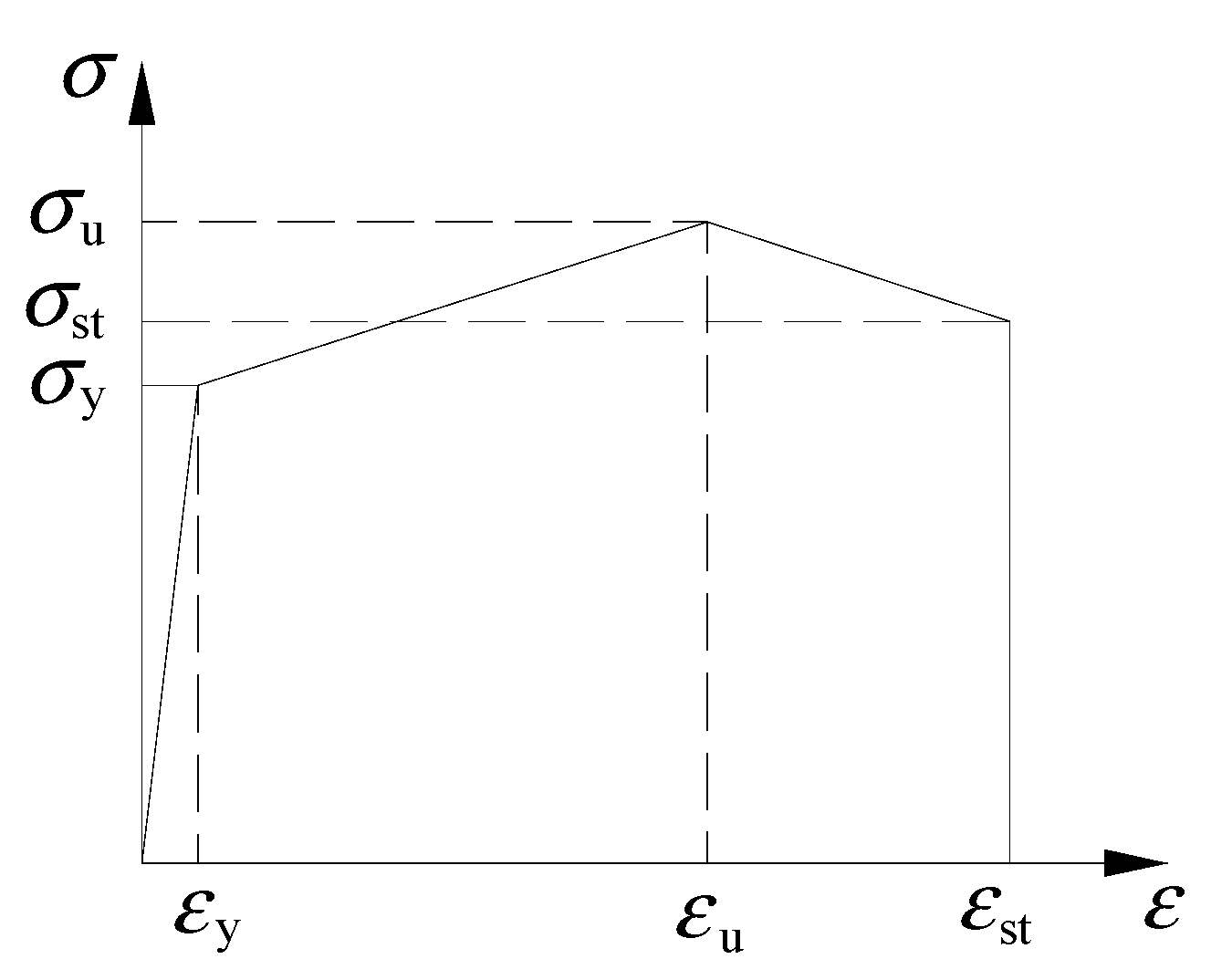
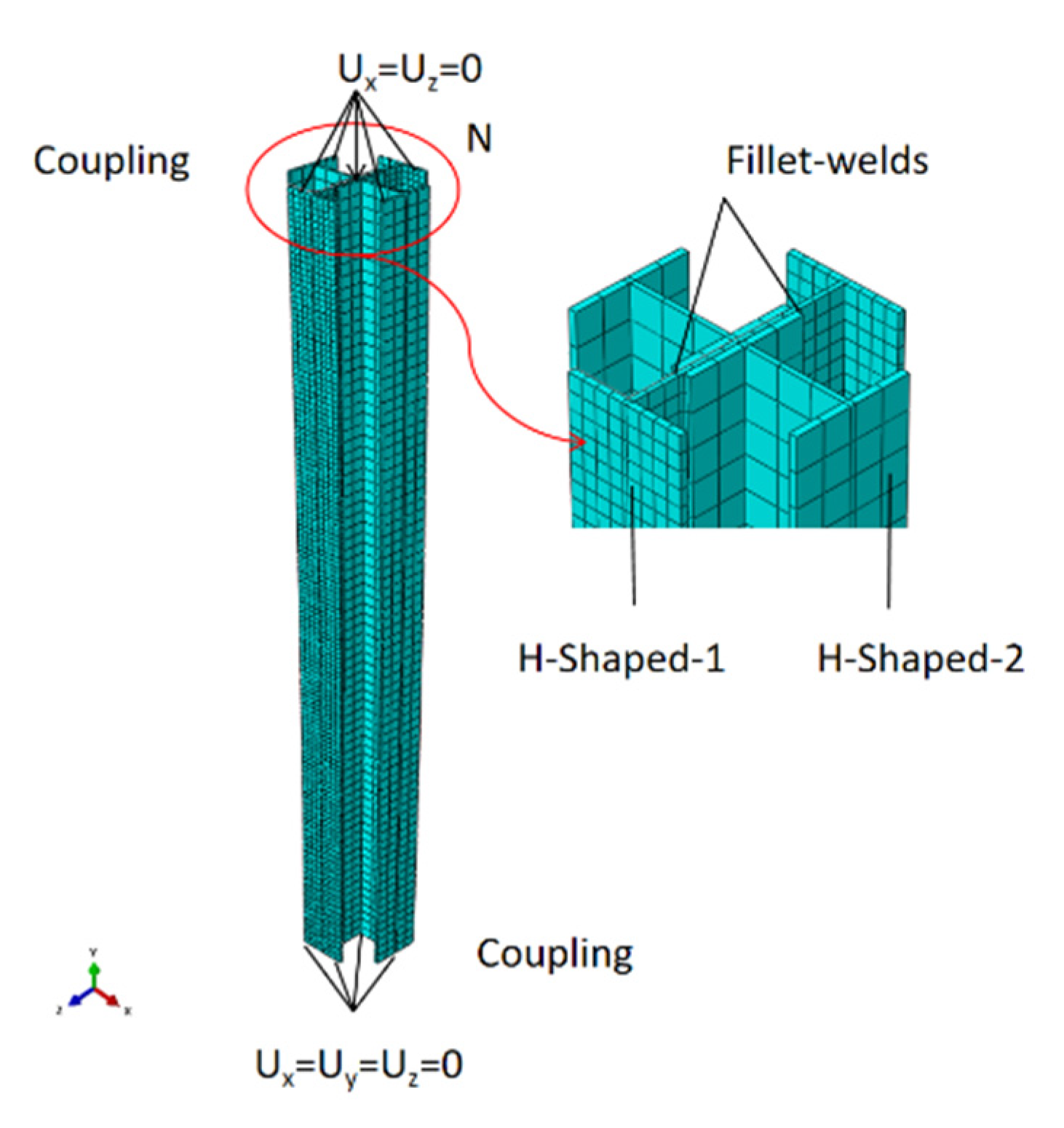
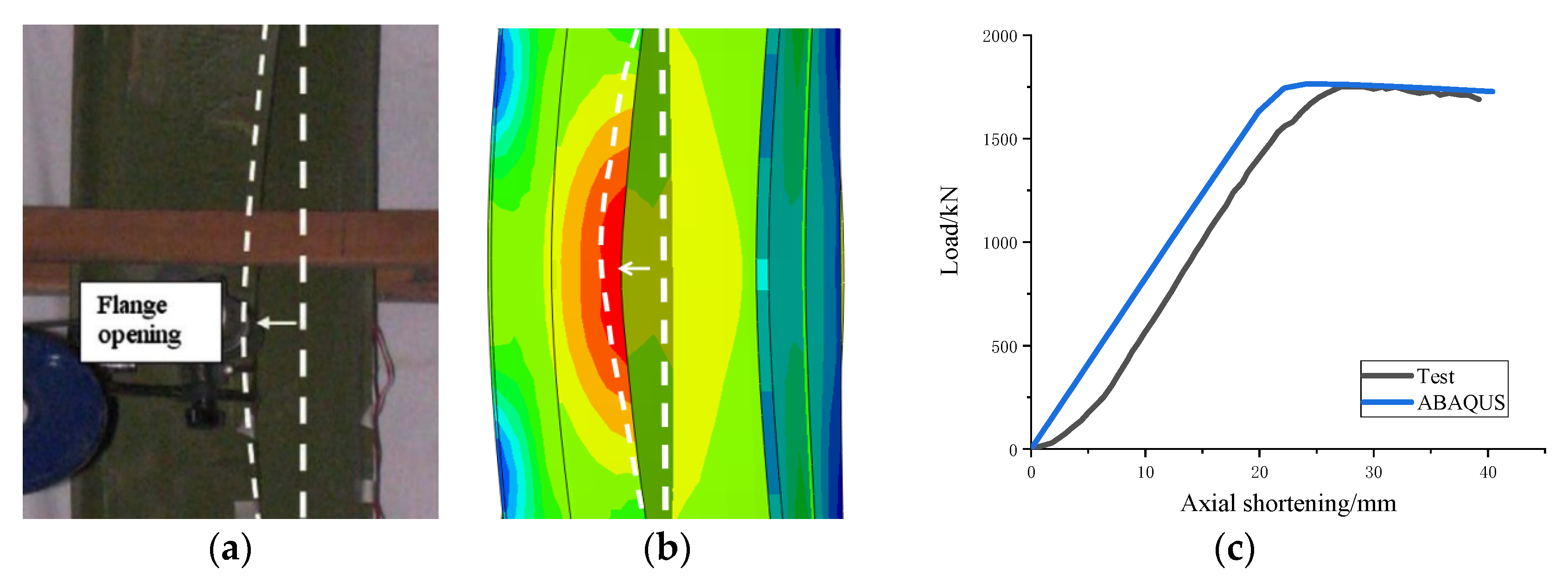
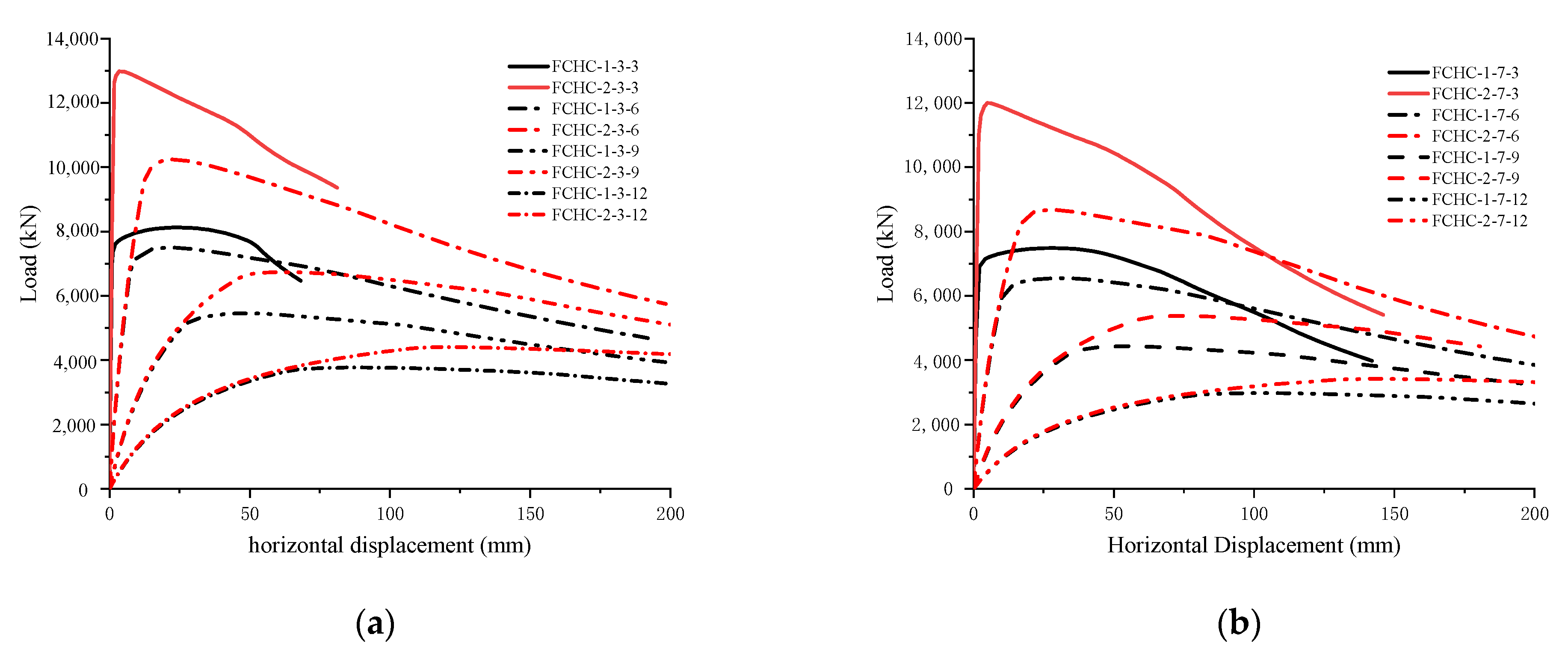







| Q345 | Q460 | |||||||||||||
|---|---|---|---|---|---|---|---|---|---|---|---|---|---|---|
| Number | E/MPa | σy 1/MPa | εy | σu/MPa | εu | σst/MPa | εst | E/MPa | σy/MPa | εy | σu/MPa | εu | σst/MPa | εst |
| 1 | 205,000 | 345 | 0.00184 | 458.55 | 0.11682 | 341.366 | 0.17081 | 210,000 | 531.9 | 0.028 | 657 | 0.140 | 631.3 | 0.2166 |
| 2 | 206,000 | 320 | 0.00164 | 455.83 | 0.13819 | 334.604 | 0.2240 | 212,000 | 492.9 | 0.020 | 643.5 | 0.142 | 598.6 | 0.2382 |
| 3 | 207,000 | 335 | 0.0019 | 461.84 | 0.13457 | 332.958 | 0.20475 | 211,000 | 492.3 | 0.024 | 631.2 | 0.147 | 608.4 | 0.2312 |
| Mean | 206,000 | 333.33 | 0.0018 | 458.33 | 0.1299 | 336.31 | 0.20 | 211,000 | 505.7 | 0.024 | 643.9 | 0.143 | 612.77 | 0.2287 |
| Column Strength Curves | e0/l for Second-Order Analysis 2 |
|---|---|
| Curve a | 1/400 |
| Curve b | 1/350 |
| Curve c | 1/300 |
| Curve d | 1/250 |
| H-Shapes | Section | Geometric Dimensions/mm | Area/cm2 | Moment of Inertia 3/cm4 | Radius of Gyration 3/cm | ||||||
|---|---|---|---|---|---|---|---|---|---|---|---|
| H | B | Tw | Tf | R | Ix | Iy | Ix | Iy | |||
| HW | HW 150 * 150 | 150 | 150 | 7 | 10 | 8 | 30 | 1620 | 563 | 6.39 | 3.76 |
| HW 200 * 200 | 200 | 200 | 8 | 12 | 13 | 63.53 | 4720 | 1600 | 8.61 | 5.02 | |
| HW 250 * 250 | 250 | 250 | 9 | 14 | 13 | 91.43 | 10700 | 3650 | 10.8 | 6.31 | |
| HM | HM 300 * 200 | 294 | 200 | 8 | 12 | 13 | 71.05 | 11100 | 1600 | 12.5 | 4.74 |
| HM 350 * 250 | 340 | 250 | 9 | 14 | 13 | 99.53 | 21200 | 3650 | 14.6 | 6.05 | |
| HM 400 * 300 | 390 | 300 | 10 | 16 | 13 | 133.3 | 37900 | 7200 | 16.9 | 7.35 | |
| HN | HN 300 * 150 | 300 | 150 | 6.5 | 9 | 13 | 46.78 | 7210 | 508 | 12.4 | 3.29 |
| HN 400 * 200 | 400 | 200 | 8 | 13 | 13 | 83.37 | 23500 | 1740 | 16.8 | 4.56 | |
| HN 450 * 200 | 450 | 200 | 9 | 14 | 13 | 95.43 | 32900 | 1870 | 18.6 | 4.42 | |
| HN 500 * 200 | 500 | 200 | 10 | 16 | 13 | 112.3 | 46800 | 2140 | 20.4 | 4.36 | |
| Specimen Group 4 | Section | Area/cm2 | Moment of Inertia/cm4 | Radius of Gyration/cm | λ = L/min(ix, iy) | ||||||||
|---|---|---|---|---|---|---|---|---|---|---|---|---|---|
| IX | IY | iX | iY | L = 12m | L = 9m | L = 6m | L = 3m | Q345 | Q460 | ||||
| FCHC-X-1 | H-shape-1 | HN 300 * 150 | 106.78 | 8336 | 7422 | 8.84 | 8.34 | 143.88 | 107.91 | 71.94 | 35.97 | 0.825 | 0.715 |
| H-shape-2 | HN 150 * 150 | ||||||||||||
| FCHC-X-2 | H-shape-1 | HN 400 * 200 | 210.43 | 26,700 | 24,923 | 11.26 | 10.88 | 110.29 | 82.72 | 55.15 | 27.57 | 0.825 | 0.715 |
| H-shape-2 | HN 200 * 200 | ||||||||||||
| FCHC-X-3 | H-shape-1 | HN 450 * 200 | 278.29 | 40,200 | 53,936 | 12.02 | 13.92 | 99.83 | 74.88 | 49.92 | 24.96 | 0.825 | 0.715 |
| H-shape-2 | HN 250 * 250 | ||||||||||||
| FCHC-X-4 | H-shape-1 | HN 500 * 200 | 295.16 | 54,100 | 54,443 | 13.54 | 13.58 | 88.63 | 66.47 | 44.31 | 22.16 | 0.825 | 0.715 |
| H-shape-2 | HN 250 * 250 | ||||||||||||
| FCHC-X-5 | H-shape-1 | HM 300 * 200 | 131.05 | 12,226 | 8585 | 9.66 | 8.09 | 148.33 | 111.25 | 74.17 | 37.08 | 0.825 | 0.715 |
| H-shape-2 | HW150 * 150 | ||||||||||||
| FCHC-X-6 | H-shape-1 | HM 350 * 250 | 226.59 | 24,400 | 26,965 | 10.38 | 10.91 | 115.61 | 86.71 | 57.80 | 28.90 | 0.825 | 0.715 |
| H-shape-2 | HW 200 * 200 | ||||||||||||
| FCHC-X-7 | H-shape-1 | HM 400 * 300 | 260.36 | 41,100 | 30,648 | 12.56 | 10.85 | 110.60 | 82.95 | 55.30 | 27.65 | 0.825 | 0.715 |
| H-shape-2 | HM 200 * 200 | ||||||||||||
| FCHC-X-8 | H-shape-1 | HM 500 * 200 | 254.4 | 50,000 | 57,171 | 14.02 | 14.99 | 85.59 | 64.19 | 42.80 | 21.40 | 0.825 | 0.715 |
| H-shape-2 | HW 300 * 200 | ||||||||||||
| FCHC-X-9 | H-shape-1 | HM 500 * 200 | 205.86 | 47,816 | 39,038 | 15.24 | 13.77 | 87.15 | 65.36 | 43.57 | 21.79 | 0.825 | 0.715 |
| H-shape-2 | HM 300 * 150 | ||||||||||||
| Column Buckling Curve | α1 | α2 | α3 | |
|---|---|---|---|---|
| a | 0.41 | 0.986 | 0.152 | |
| b | 0.65 | 0.965 | 0.300 | |
| c | 0.73 | 0.906 | 0.595 | |
| 1.216 | 0.302 | |||
| d | 1.35 | 0.868 | 0.915 | |
| 1.375 | 0.432 | |||
| Column Buckling Curve | a0 | a | b | c | d |
|---|---|---|---|---|---|
| Imperfection factor α | 0.13 | 0.21 | 0.34 | 0.49 | 0.76 |
| Specimen 5 | Buckling Load Nu/kN | GB 50017 | EN 1993-1-1 | ANSI/AISC 360 | Errors of GB 50017/% | Errors of EN 1993-1-1/% | Errors of ANSI/AISC 360/% | |||||||
|---|---|---|---|---|---|---|---|---|---|---|---|---|---|---|
| Curve b | Curve c | Curve b | Curve c | |||||||||||
| FCHC-1-1-3 | 3185.85 | 0.895 | 35.97 | 0.46 | 0.887 | 0.821 | 0.901 | 0.865 | 0.915 | 0.9 | 9.0 | −0.7 | 3.5 | −2.2 |
| FCHC-1-1-6 | 2464.14 | 0.692 | 71.94 | 0.92 | 0.650 | 0.543 | 0.647 | 0.587 | 0.701 | 6.5 | 27.6 | 7.0 | 18.0 | −1.2 |
| FCHC-1-1-9 | 1470.55 | 0.413 | 107.91 | 1.38 | 0.394 | 0.347 | 0.389 | 0.356 | 0.449 | 4.8 | 19.0 | 6.2 | 16.1 | −8.1 |
| FCHC-1-1-12 | 930.98 | 0.262 | 143.88 | 1.84 | 0.245 | 0.227 | 0.242 | 0.225 | 0.258 | 6.8 | 15.0 | 8.1 | 16.1 | 1.3 |
| FCHC-1-2-3 | 6624.04 | 0.944 | 27.57 | 0.35 | 0.926 | 0.885 | 0.944 | 0.922 | 0.949 | 2.0 | 6.8 | 0.0 | 2.4 | −0.5 |
| FCHC-1-2-6 | 5274.34 | 0.752 | 55.15 | 0.71 | 0.776 | 0.671 | 0.780 | 0.721 | 0.811 | −3.1 | 12.1 | −3.6 | 4.3 | −7.3 |
| FCHC-1-2-9 | 3518.71 | 0.502 | 82.72 | 1.06 | 0.564 | 0.469 | 0.560 | 0.506 | 0.625 | −11.1 | 7.0 | −10.4 | −0.9 | −19.7 |
| FCHC-1-2-12 | 2383.75 | 0.340 | 110.29 | 1.41 | 0.381 | 0.337 | 0.376 | 0.344 | 0.434 | −10.8 | 0.8 | −9.7 | −1.3 | −21.6 |
| FCHC-1-3-3 | 8118.69 | 0.875 | 24.96 | 0.32 | 0.937 | 0.904 | 0.957 | 0.939 | 0.958 | −6.6 | −3.2 | −8.5 | −6.8 | −8.7 |
| FCHC-1-3-6 | 7504.94 | 0.809 | 49.92 | 0.64 | 0.810 | 0.712 | 0.817 | 0.762 | 0.843 | −0.1 | 13.6 | −0.9 | 6.2 | −4.0 |
| FCHC-1-3-9 | 5455.71 | 0.588 | 74.88 | 0.96 | 0.626 | 0.522 | 0.623 | 0.564 | 0.680 | −6.1 | 12.7 | −5.6 | 4.3 | −13.6 |
| FCHC-1-3-12 | 3775.76 | 0.407 | 99.83 | 1.28 | 0.442 | 0.383 | 0.437 | 0.398 | 0.504 | −8.0 | 6.3 | −6.9 | 2.3 | −19.3 |
| FCHC-1-4-3 | 9268.63 | 0.942 | 22.16 | 0.28 | 0.948 | 0.925 | 0.970 | 0.957 | 0.967 | −0.7 | 1.8 | −2.9 | −1.6 | −2.6 |
| FCHC-1-4-6 | 8402.15 | 0.854 | 44.31 | 0.57 | 0.843 | 0.756 | 0.853 | 0.804 | 0.874 | 1.3 | 12.9 | 0.1 | 6.2 | −2.3 |
| FCHC-1-4-9 | 6506.96 | 0.661 | 66.47 | 0.85 | 0.693 | 0.583 | 0.692 | 0.630 | 0.738 | −4.6 | 13.4 | −4.4 | 5.0 | −10.4 |
| FCHC-1-4-12 | 4708.24 | 0.479 | 88.63 | 1.14 | 0.519 | 0.432 | 0.514 | 0.466 | 0.583 | −7.9 | 10.7 | −7.0 | 2.7 | −17.9 |
| FCHC-1-5-3 | 3967.94 | 0.908 | 37.08 | 0.48 | 0.882 | 0.812 | 0.895 | 0.857 | 0.910 | 3.0 | 11.8 | 1.5 | 6.0 | −0.2 |
| FCHC-1-5-6 | 2902.73 | 0.665 | 74.17 | 0.95 | 0.632 | 0.527 | 0.629 | 0.569 | 0.685 | 5.1 | 26.2 | 5.7 | 16. | −3.0 |
| FCHC-1-5-9 | 1698.62 | 0.389 | 111.25 | 1.43 | 0.376 | 0.333 | 0.371 | 0.340 | 0.427 | 3.4 | 16.7 | 4.7 | 14.4 | −9.0 |
| FCHC-1-5-12 | 1068.43 | 0.245 | 148.33 | 1.90 | 0.232 | 0.216 | 0.229 | 0.214 | 0.243 | 5.4 | 13.0 | 6.7 | 14.2 | 0.7 |
| FCHC-1-6-3 | 6852.63 | 0.907 | 28.9 | 0.37 | 0.920 | 0.875 | 0.938 | 0.913 | 0.944 | −1.4 | 3.7 | −3.2 | −0.6 | −3.9 |
| FCHC-1-6-6 | 5494.11 | 0.727 | 57.8 | 0.74 | 0.758 | 0.650 | 0.760 | 0.700 | 0.795 | −4.0 | 11.9 | −4.3 | 4.0 | −8.5 |
| FCHC-1-6-9 | 3773.66 | 0.500 | 86.71 | 1.11 | 0.534 | 0.448 | 0.529 | 0.479 | 0.597 | −6.4 | 11.6 | −5.5 | 4.4 | −16.3 |
| FCHC-1-6-12 | 2524.81 | 0.334 | 115.61 | 1.48 | 0.354 | 0.316 | 0.349 | 0.321 | 0.399 | −5.5 | 5.7 | −4.3 | 4.2 | −16.3 |
| FCHC-1-7-3 | 7486.38 | 0.863 | 27.65 | 0.35 | 0.925 | 0.884 | 0.944 | 0.921 | 0.949 | −6.8 | −2.4 | −8.6 | −6.4 | −9.1 |
| FCHC-1-7-6 | 6551.61 | 0.755 | 55.3 | 0.71 | 0.775 | 0.670 | 0.779 | 0.719 | 0.811 | −2.6 | 12.7 | −3.1 | 4.9 | −6.9 |
| FCHC-1-7-9 | 4437.98 | 0.511 | 82.95 | 1.06 | 0.562 | 0.467 | 0.558 | 0.504 | 0.623 | −9.1 | 9.4 | −8.3 | 1.4 | −18.0 |
| FCHC-1-7-12 | 2980.45 | 0.343 | 110.6 | 1.42 | 0.379 | 0.336 | 0.375 | 0.343 | 0.432 | −9.5 | 2.2 | −8.3 | 0.1 | −20.4 |
| FCHC-1-8-3 | 8141.4 | 0.960 | 21.4 | 0.27 | 0.952 | 0.931 | 0.974 | 0.962 | 0.969 | 0.9 | 3.1 | −1.4 | −0.2 | −0.9 |
| FCHC-1-8-6 | 7761.5 | 0.915 | 42.8 | 0.55 | 0.852 | 0.768 | 0.862 | 0.816 | 0.882 | 7.5 | 19.2 | 6.2 | 12.2 | 3.8 |
| FCHC-1-8-9 | 7332.14 | 0.865 | 64.19 | 0.82 | 0.711 | 0.600 | 0.711 | 0.648 | 0.753 | 21.7 | 44.0 | 21.7 | 33.4 | 14.8 |
| FCHC-1-8-12 | 5100.31 | 0.601 | 85.59 | 1.10 | 0.542 | 0.454 | 0.537 | 0.486 | 0.605 | 10.9 | 32.6 | 11.9 | 23.7 | −0.5 |
| FCHC-1-9-3 | 6646.77 | 0.969 | 21.79 | 0.28 | 0.950 | 0.928 | 0.972 | 0.960 | 0.968 | 2.0 | 4.4 | −0.3 | 0.9 | 0.1 |
| FCHC-1-9-6 | 5947.22 | 0.867 | 43.57 | 0.56 | 0.847 | 0.762 | 0.858 | 0.810 | 0.878 | 2.3 | 13.7 | 1.1 | 7.0 | −1.3 |
| FCHC-1-9-9 | 4375.57 | 0.638 | 65.36 | 0.84 | 0.702 | 0.592 | 0.701 | 0.639 | 0.746 | −9.1 | 7.8 | −9.1 | −0.2 | −14.5 |
| FCHC-1-9-12 | 3100.73 | 0.452 | 87.15 | 1.12 | 0.530 | 0.446 | 0.525 | 0.476 | 0.594 | −14.8 | 1.4 | −14.0 | −5.0 | −23.9 |
| Average | − | − | − | − | − | − | − | − | − | −1.2 | 11.5 | −1.4 | 5.9 | −7.5 |
| Specimen 6 | Buckling Load Nu/kN | GB 50017 | EN 1993-1-1 | ANSI/AISC 360 | Errors of GB 50017% | Errors of EN 1993-1-1% | Errors of ANSI/AISC 360% | |||||||
|---|---|---|---|---|---|---|---|---|---|---|---|---|---|---|
| Curve b | Curve c | Curve b | Curve c | |||||||||||
| FCHC-2-1-3 | 4823.37 | 0.893 | 35.97 | 0.56 | 0.846 | 0.760 | 0.856 | 0.808 | 0.877 | 5.5 | 17.5 | 4.3 | 10.5 | 1.9 |
| FCHC-2-1-6 | 3096.42 | 0.573 | 71.94 | 1.12 | 0.527 | 0.439 | 0.522 | 0.473 | 0.591 | 8.7 | 30.7 | 9.8 | 21.3 | −2.9 |
| FCHC-2-1-9 | 1702.21 | 0.315 | 107.91 | 1.68 | 0.287 | 0.262 | 0.283 | 0.262 | 0.310 | 10.0 | 20.2 | 11.4 | 20.3 | 1.7 |
| FCHC-2-1-12 | 1036.94 | 0.192 | 143.88 | 2.24 | 0.172 | 0.164 | 0.170 | 0.161 | 0.174 | 11.4 | 17.2 | 12.7 | 19.5 | 10.2 |
| FCHC-2-2-3 | 9668.4 | 0.909 | 27.57 | 0.43 | 0.899 | 0.839 | 0.914 | 0.881 | 0.926 | 1.1 | 8.3 | −0.6 | 3.1 | −1.8 |
| FCHC-2-2-6 | 6877.06 | 0.646 | 55.15 | 0.86 | 0.688 | 0.578 | 0.687 | 0.625 | 0.734 | −6.1 | 11.8 | −5.9 | 3.5 | −11.9 |
| FCHC-2-2-9 | 4299.73 | 0.404 | 82.72 | 1.29 | 0.437 | 0.367 | 0.432 | 0.393 | 0.498 | −7.5 | 10.2 | −6.4 | 2.8 | −18.9 |
| FCHC-2-2-12 | 2755.97 | 0.259 | 110.29 | 1.72 | 0.276 | 0.254 | 0.273 | 0.253 | 0.297 | −6.2 | 2.1 | −5.0 | 2.4 | −12.7 |
| FCHC-2-3-3 | 13,277.21 | 0.922 | 24.96 | 0.39 | 0.913 | 0.863 | 0.930 | 0.903 | 0.939 | 1.0 | 6.8 | −0.9 | 2.1 | −1.7 |
| FCHC-2-3-6 | 11,027.1 | 0.728 | 49.92 | 0.78 | 0.736 | 0.627 | 0.738 | 0.676 | 0.776 | −1.1 | 16.1 | −1.3 | 7.7 | −6.2 |
| FCHC-2-3-9 | 7836.95 | 0.479 | 74.88 | 1.17 | 0.501 | 0.418 | 0.496 | 0.450 | 0.565 | −4.5 | 14.7 | −3.5 | 6.5 | −15.3 |
| FCHC-2-3-12 | 5427.25 | 0.313 | 99.83 | 1.56 | 0.326 | 0.295 | 0.322 | 0.297 | 0.362 | −4.0 | 6.4 | −2.8 | 5.5 | −13.4 |
| FCHC-2-4-3 | 14,044.01 | 0.911 | 22.16 | 0.35 | 0.928 | 0.889 | 0.947 | 0.926 | 0.951 | −1.9 | 2.4 | −3.9 | −1.6 | −4.3 |
| FCHC-2-4-6 | 11,477.5 | 0.782 | 44.31 | 0.69 | 0.784 | 0.680 | 0.789 | 0.730 | 0.819 | −0.3 | 14.9 | −0.8 | 7.1 | −4.5 |
| FCHC-2-4-9 | 8021.87 | 0.555 | 66.47 | 1.04 | 0.579 | 0.481 | 0.574 | 0.519 | 0.638 | −4.1 | 15.4 | −3.4 | 6.9 | −13.0 |
| FCHC-2-4-12 | 5513.34 | 0.377 | 88.63 | 1.38 | 0.394 | 0.333 | 0.389 | 0.356 | 0.450 | −4.3 | 13.3 | −3.1 | 6.0 | −16.1 |
| FCHC-2-5-3 | 5455.35 | 0.823 | 37.08 | 0.58 | 0.839 | 0.750 | 0.848 | 0.798 | 0.869 | −1.8 | 9.8 | −2.9 | 3.1 | −5.3 |
| FCHC-2-5-6 | 3605.41 | 0.544 | 74.17 | 1.16 | 0.507 | 0.423 | 0.502 | 0.455 | 0.571 | 7.2 | 28.7 | 8.3 | 19.5 | −4.8 |
| FCHC-2-5-9 | 1954.77 | 0.295 | 111.25 | 1.73 | 0.272 | 0.250 | 0.269 | 0.249 | 0.292 | 8.4 | 17.8 | 9.8 | 18.3 | 1.2 |
| FCHC-2-5-12 | 1185.65 | 0.179 | 148.33 | 2.31 | 0.163 | 0.155 | 0.161 | 0.152 | 0.164 | 9.8 | 15.1 | 11.0 | 17.5 | 9.1 |
| FCHC-2-6-3 | 10,438.2 | 0.894 | 28.9 | 0.45 | 0.891 | 0.827 | 0.905 | 0.870 | 0.919 | 0.3 | 8.1 | −1.3 | 2.7 | −2.7 |
| FCHC-2-6-6 | 7526.8 | 0.653 | 57.8 | 0.90 | 0.663 | 0.554 | 0.660 | 0.599 | 0.712 | −1.5 | 17.8 | −1.1 | 9.0 | −8.3 |
| FCHC-2-6-9 | 4680.68 | 0.400 | 86.71 | 1.35 | 0.408 | 0.357 | 0.403 | 0.368 | 0.465 | −1.9 | 11.9 | −0.7 | 8.7 | −14.1 |
| FCHC-2-6-12 | 2993.16 | 0.251 | 115.61 | 1.80 | 0.255 | 0.236 | 0.251 | 0.234 | 0.270 | −1.3 | 6.6 | −0.1 | 7.4 | −6.9 |
| FCHC-2-7-3 | 11,999.7 | 0.911 | 27.65 | 0.43 | 0.898 | 0.839 | 0.914 | 0.881 | 0.925 | 1.5 | 8.7 | −0.2 | 3.5 | −1.5 |
| FCHC-2-7-6 | 8685.63 | 0.660 | 55.3 | 0.86 | 0.686 | 0.577 | 0.685 | 0.623 | 0.733 | −3.9 | 14.4 | −3.8 | 5.8 | −10.0 |
| FCHC-2-7-9 | 5378.89 | 0.409 | 82.95 | 1.29 | 0.435 | 0.365 | 0.430 | 0.392 | 0.497 | −6.1 | 11.8 | −5.0 | 4.3 | −17.7 |
| FCHC-2-7-12 | 3421.55 | 0.260 | 110.6 | 1.72 | 0.275 | 0.253 | 0.271 | 0.252 | 0.295 | −5.4 | 2.9 | −4.2 | 3.2 | −11.9 |
| FCHC-2-8-3 | 12,190.7 | 0.928 | 21.4 | 0.33 | 0.932 | 0.896 | 0.952 | 0.932 | 0.954 | −0.4 | 3.6 | −2.5 | −0.4 | −2.8 |
| FCHC-2-8-6 | 10,538.5 | 0.782 | 42.8 | 0.67 | 0.796 | 0.695 | 0.802 | 0.745 | 0.830 | −1.8 | 12.5 | −2.5 | 5.0 | −5.8 |
| FCHC-2-8-9 | 7597.49 | 0.570 | 64.19 | 1.00 | 0.600 | 0.499 | 0.597 | 0.539 | 0.658 | −5.1 | 14.2 | −4.5 | 5.6 | −13.3 |
| FCHC-2-8-12 | 5380.87 | 0.396 | 85.59 | 1.33 | 0.416 | 0.363 | 0.411 | 0.375 | 0.475 | −4.6 | 9.1 | −3.5 | 5.8 | −16.5 |
| FCHC-2-9-3 | 9738.74 | 0.935 | 21.79 | 0.34 | 0.930 | 0.892 | 0.949 | 0.929 | 0.953 | 0.6 | 4.8 | −1.5 | 0.7 | −1.8 |
| FCHC-2-9-6 | 8012.2 | 0.770 | 43.57 | 0.68 | 0.790 | 0.688 | 0.795 | 0.737 | 0.824 | −2.6 | 11.9 | −3.2 | 4.4 | −6.6 |
| FCHC-2-9-9 | 5454.75 | 0.524 | 65.36 | 1.02 | 0.589 | 0.490 | 0.585 | 0.529 | 0.648 | −11.1 | 7.0 | −10.4 | −0.9 | −19.1 |
| FCHC-2-9-12 | 3734.73 | 0.359 | 87.15 | 1.36 | 0.405 | 0.355 | 0.400 | 0.365 | 0.462 | −11.3 | 1.1 | −10.2 | −1.7 | −22.3 |
| Average | − | − | − | − | − | − | − | − | − | −0.9 | 11.8 | −0.8 | 6.8 | −7.5 |
Publisher’s Note: MDPI stays neutral with regard to jurisdictional claims in published maps and institutional affiliations. |
© 2021 by the authors. Licensee MDPI, Basel, Switzerland. This article is an open access article distributed under the terms and conditions of the Creative Commons Attribution (CC BY) license (https://creativecommons.org/licenses/by/4.0/).
Share and Cite
Lu, L.; Wang, D.; Dai, Z.; Luo, T.; Ding, S.; Hao, H. Global Buckling Investigation of the Flanged Cruciform H-shapes Columns (FCHCs). Appl. Sci. 2021, 11, 11458. https://doi.org/10.3390/app112311458
Lu L, Wang D, Dai Z, Luo T, Ding S, Hao H. Global Buckling Investigation of the Flanged Cruciform H-shapes Columns (FCHCs). Applied Sciences. 2021; 11(23):11458. https://doi.org/10.3390/app112311458
Chicago/Turabian StyleLu, Linfeng, Di Wang, Zifan Dai, Tengfei Luo, Songlin Ding, and Hanlin Hao. 2021. "Global Buckling Investigation of the Flanged Cruciform H-shapes Columns (FCHCs)" Applied Sciences 11, no. 23: 11458. https://doi.org/10.3390/app112311458
APA StyleLu, L., Wang, D., Dai, Z., Luo, T., Ding, S., & Hao, H. (2021). Global Buckling Investigation of the Flanged Cruciform H-shapes Columns (FCHCs). Applied Sciences, 11(23), 11458. https://doi.org/10.3390/app112311458







